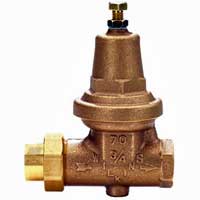uscpsycho
Member
I had no problem with my water pressure until the water department showed up about a week ago. They replaced my water meter and later that day I noticed my water pressure was over 100psi. I thought they did something wrong so I called and asked them to come fix it.
It stayed 100+ until they came the next day. They took a look and insisted my water pressure reducer was to blame and that their water meter wasn't the problem. They insisted that this problem started shortly after the meter was replaced was a coincidence.
So I installed a new water pressure reducer and set it to the mid 70's. It was fine for a few days until it spiked to over 100 psi. I thought that was weird because it's a brand new reducer. So I adjusted the water pressure back down to the mid 70's and last night it spiked to 120+. I caught it right away and adjusted the pressure back down to the 70's. This morning it spiked to 120 and within the hour came back down to the 70's without my intervention.
What in the world is happening? This is the reducer I am using. I just checked the specs and the maximum psi is 75. I just noticed this, so when I am reducing the water pressure to the mid 70's I am setting it to the reducer's maximum psi. Maybe I shouldn't do that? But doesn't 75 max mean that it should be impossible for the water pressure to ever go over 75? Is it possible I have a faulty reducer or is something else going on?
Please help me troubleshoot this, having my water pressure spiking so high is not good! THANKS!

It stayed 100+ until they came the next day. They took a look and insisted my water pressure reducer was to blame and that their water meter wasn't the problem. They insisted that this problem started shortly after the meter was replaced was a coincidence.
So I installed a new water pressure reducer and set it to the mid 70's. It was fine for a few days until it spiked to over 100 psi. I thought that was weird because it's a brand new reducer. So I adjusted the water pressure back down to the mid 70's and last night it spiked to 120+. I caught it right away and adjusted the pressure back down to the 70's. This morning it spiked to 120 and within the hour came back down to the 70's without my intervention.
What in the world is happening? This is the reducer I am using. I just checked the specs and the maximum psi is 75. I just noticed this, so when I am reducing the water pressure to the mid 70's I am setting it to the reducer's maximum psi. Maybe I shouldn't do that? But doesn't 75 max mean that it should be impossible for the water pressure to ever go over 75? Is it possible I have a faulty reducer or is something else going on?
Please help me troubleshoot this, having my water pressure spiking so high is not good! THANKS!

